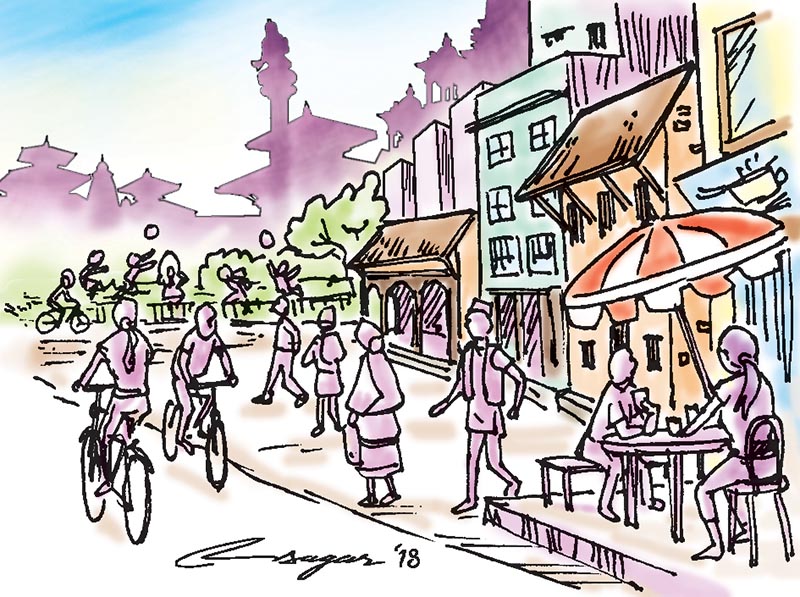Placemaking in Valley: Redefining public places
Placemaking is a multi-faceted approach to the planning, design and management of public spaces. It capitalises on a local community’s assets with the intention of creating public spaces that promote people’s health, happiness and wellbeing
Rapid urbanisation is eating up public places. Failure to act now could mean cities very soon will be without open spaces. So it is high time we started talking about “Placemaking”. Placemaking is a multi-faceted approach to the planning, design and management of public spaces. Placemaking capitalises on a local community’s assets, inspiration and potential with the intention of creating public spaces that promote people’s health, happiness and well-being.
The Placemaking concepts originated in the 1960s, when writers such as Jane Jacobs and William H Whyte offered groundbreaking ideas about designing cities that catered to people, not just to cars and shopping centres. Their work focused on the importance of lively neighbourhoods and inviting public spaces. Jacobs advocated citizen ownership of streets through the now-famous idea of “eyes on the street.” Whyte emphasised essential elements for creating social life in public spaces.
At its most basic, Placemaking practice aims to improve the quality of a public place and the lives of its community. It seeks to build or improve public space, spark public discourse, create beauty and delight, engender civic pride, connect neighbourhoods, support community health and safety, grow social justice, catalyse economic development, promote environmental sustainability, and of course nurture an authentic “sense of place”.
It aims to provide opportunities for residents to meet and become involved in community life, support the development of community groups and networks, identify local community needs, aspirations and strengths, introduce residents to local services and programs and connect residents to decision-makers. Time has come we for starting the practice of Placemaking in the Kathmandu Valley to restore its former glory.
Kathmandu has long suffered from mismanagement. Most alarming of all is our city’s increasing criminal activities due to lack of lively public spaces. Therefore, the idea of Placemaking will somehow contribute to provide knowledge and awareness on the urgency of transforming the dull and dead spaces of Kathmandu into lively and vibrant places. More than just promoting better urban design, Placemaking facilitates creative patterns of use, paying particular attention to the physical, cultural and social identities that define a place and support its ongoing evolution. By improving all of the spaces that compromise the gathering places within the Valley – streets, sidewalks, parks, buildings, squares and other public spaces – we can invite greater interaction between people and foster healthier, more social and economically viable communities.
Thus the unique historical urban culture of the Valley represented by a coherent synthesis of people and places can be brought back through Placemaking.
Unfortunately, the rigid planning processes of our country have become so institutionalised that community stakeholders rarely have the chance to voice their own ideas and aspirations about the places they inhabit. Placemaking can break down these soils by showing planners, designers and engineers the broad value of moving beyond the narrow focus of their own professions, disciplines and agendas. Common problems like traffic-dominated streets, less-used public spaces and isolated or underperforming development projects can be addressed or altogether avoided by embracing a model of Placemaking that views a place in its entirety.
One of the ways for implementing Placemaking model in Kathmandu can be through “alley revitalisation”. The alleys are as old as the city itself. But alleys today are dark, unsafe and unappealing. They have become spots for dumping garbage and backdrops for criminal activities. They can be transformed into vibrant places just with a few simple aesthetic and functional improvements like proper lighting, heritage shops, retail shops, colourful stalls, galleries, art installations, performance spaces, nature retreats, street markets, cafés and restaurants.
This process of alley activation can be achieved through community participation thus strengthening a sense of ownership. Some of the most enticing alleys that are picturesque on their own are Colmar, Alsace Region, France; Birgu, Malta; Dubrovnik, Croatia; Ping Yao, China; and Mykonos Island, Greece.
The Barcelona Public Market of Spain can be a great example for Kathmandu. In Barcelona, markets act as catalysts for creating centres in neighbourhoods that have lost their sense of place.
The market is a public edifice that guarantees public activity. It is the symbol of centrality. The public markets have made it easier for residents to connect with their neighbours. These markets sell all the necessities for daily needs; in between, one can find some corner grocers, weekly farmer markets, flea and artisan markets, and other small-scale distribution points.
Placemaking in Barcelona is based on a simple principle: if you plan cities for cars and traffic, you will get cars and traffic. If you plan for people and places, you will get people and places. By adopting such ideas of Placemaking and lessons from other countries, hopefully we will see many public places in Kathmandu where people want to spend time because they want to, not because they have to.






